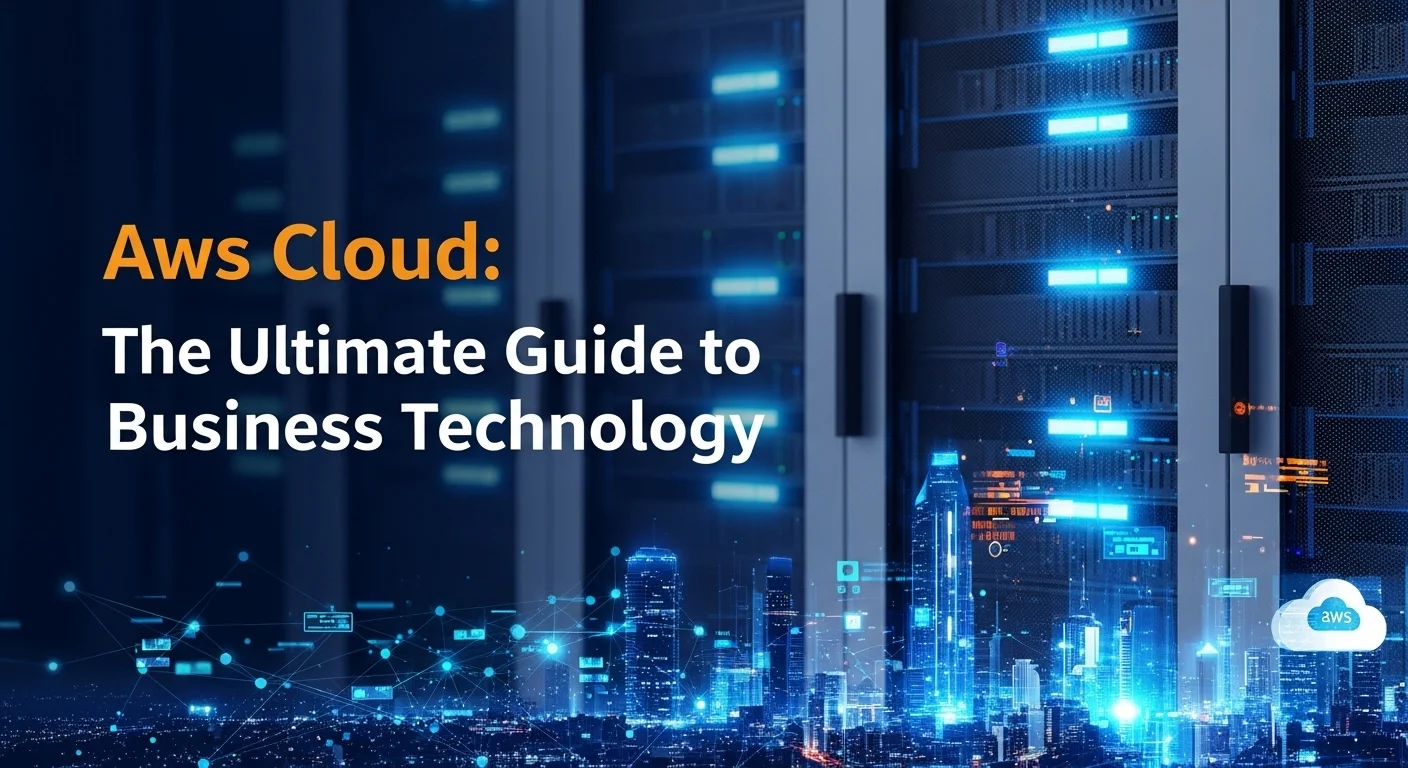AWS Cloud Explained: A Practical Guide to Boosting Your Business

Executive Summary
I remember the first time I migrated a major e-commerce site to Amazon Web Services over a decade ago. The idea of ditching our expensive, clunky physical servers felt like a huge leap of faith, but the results were nothing short of transformative. Since then, AWS has become the backbone of modern business, but I know it can still feel intimidating from the outside. This guide is my attempt to cut through the noise. I'll walk you through what AWS really is, from its incredibly flexible hosting and networking to its vast software ecosystem. You'll learn how this technology can give your business a serious competitive edge, whether you're a startup on a shoestring budget or an established company looking to innovate faster. Let's demystify this powerful platform together.
Table of Contents
Table of Contents
- What is AWS and Why Does It Matter?
- The Core Pillars of AWS Technology
- AWS Cloud Hosting Explained
- The All-in-One AWS Cloud Platform
- Secure and Fast AWS Cloud Networking
- The World of AWS Cloud Software
- The Power of AWS Managed Cloud Services
- Real-World Business Benefits of Using AWS
What is AWS and why is it important in Technology?
When people ask me what Amazon Web Services (AWS) is, I tell them to think of it as the engine that powers a huge portion of the internet they use every day. Back in 2006, Amazon flipped the script on business technology. Instead of forcing companies to buy and maintain their own expensive server rooms, they offered a pay-as-you-go cloud model. It was revolutionary. Suddenly, anyone could access massive computing power, storage, and databases over the internet, paying only for what they used, like a utility bill. This leveled the playing field, allowing tiny startups to use the same world-class infrastructure as massive corporations. Today, the importance of AWS is undeniable; it's the invisible foundation for countless streaming services, social media apps, and even critical government systems.
At its heart, AWS offers different service models to fit any need. For those who want maximum control, there's Infrastructure as a Service (IaaS), where AWS provides the fundamental building blocks like virtual servers (EC2) and storage (S3). It’s like leasing a plot of land where you can build anything you want. For those who want to focus more on code and less on managing hardware, there's Platform as a Service (PaaS). A service like AWS Elastic Beanstalk handles the underlying infrastructure for you, so you can just deploy your application. Think of it as a pre-built foundation for your house. Finally, Software as a Service (SaaS) offers ready-to-use products, like a subscription to an application. This layered approach is why AWS is so versatile, serving everyone from a solo developer with a great idea to a global company running its entire operation in the cloud.
The Pillars of Aws Cloud Technology
To really get a handle on AWS, it helps to understand its key components. I like to think of them as the five pillars that hold up this incredible ecosystem. These pillars are what make the entire AWS cloud platform so dominant and useful.
1. AWS Cloud Hosting: In my early days, web hosting meant renting a slice of a single, physical server. If you got a sudden spike in traffic, you crossed your fingers and prayed it wouldn't crash. AWS cloud hosting changed all of that. With services like Amazon EC2, you can launch virtual servers in minutes and, more importantly, scale them automatically. Imagine running an e-commerce site during a massive sale. With AWS, your site can automatically add more server power to handle the rush and then scale back down when things quiet down. You only pay for that extra power when you need it. This elasticity is a game-changer. Another key service is Amazon S3, which offers incredibly cheap and durable storage for everything from website images to data backups. This flexibility and cost-efficiency make it the go-to choice for modern businesses that need to be reliable and fast.
2. The All-in-One AWS Cloud Platform: The term AWS cloud platform refers to the whole suite of over 200 services. It's so much more than just hosting. It includes powerful databases like Amazon RDS, which takes the headache out of managing a relational database, and DynamoDB for super-fast NoSQL needs. For developers like me, the platform is a goldmine of tools for building and deploying applications. But what really excites me are the advanced services. You have tools for Machine Learning (Amazon SageMaker), Artificial Intelligence, and the Internet of Things (IoT) right at your fingertips. This means you can build incredibly sophisticated, cutting-edge applications all within one ecosystem, which speeds up innovation tremendously.
3. Secure and Fast AWS Cloud Networking: A secure, high-performance network is the lifeblood of any cloud setup. The AWS cloud networking services give you the tools to build a private, isolated network in the cloud. The cornerstone is the Amazon Virtual Private Cloud (VPC), which lets you create your own virtual network with full control over IP addresses, subnets, and security. You can build a public-facing area for your web servers and a completely private zone for your sensitive databases. Services like Elastic Load Balancing spread traffic across multiple servers to prevent overloads, ensuring your application stays online. It’s like having a highly skilled traffic cop directing cars to keep everything flowing smoothly.
4. The World of AWS Cloud Software: The idea of AWS cloud software works two ways. First, AWS offers a marketplace where you can instantly find and deploy software from thousands of vendors, from security tools to business analytics. Second, it's about the software you build *on* AWS. The platform provides incredible support for developers with kits (SDKs) for all major programming languages, making it easy to integrate AWS services into your own applications. This synergy creates a dynamic environment where you can either use powerful off-the-shelf software or build your own custom solutions with amazing speed.
5. The Power of AWS Managed Cloud Services: Let's be honest: managing cloud infrastructure can be complex. This is where AWS managed cloud services are a lifesaver. These services are designed to take the operational work off your plate. For example, Amazon RDS is a managed database service. AWS handles all the tedious but critical tasks like patching, backups, and scaling, freeing up your team to focus on innovation instead of maintenance. For many businesses I've worked with, using managed services is the key to reducing costs, improving security, and allowing their tech teams to focus on what really matters: building a better business.
Real-World Business Benefits of Using AWS
Adopting AWS brings tangible benefits that I've seen transform businesses firsthand. The most obvious one is cost savings. The pay-as-you-go model means you're trading a massive upfront investment in hardware for a variable operating expense. You pay for what you consume, which is a huge advantage for startups who can now access enterprise-grade tech without the enterprise-grade price tag.
Scalability and agility are just as important. The ability to scale resources up or down in minutes gives you the freedom to experiment. If a new product takes off, you can scale it globally in an instant. If it doesn't, you can shut it down without being stuck with expensive hardware. This agility is fueled by AWS's global infrastructure, which allows you to deploy your applications closer to your customers around the world, making their experience faster and better.
Finally, there's security and reliability. AWS invests more in security than most individual companies ever could. With robust features for data encryption, firewalls, and access control, you can build incredibly secure applications. And because their data centers are distributed worldwide, you get built-in disaster recovery capabilities, ensuring your business stays online even if one location has an issue. When you move to the AWS cloud, you're not just adopting technology; you're adopting a more efficient, powerful, and resilient way to operate.

A Deeper Look: AWS Solutions for Business and Tech
To truly master Amazon Web Services, you need to go beyond the basics and understand how its core services can be combined to solve real-world business problems. In my experience, the magic happens when you know which tool to use for the job. This guide will give you a practical walkthrough of the AWS cloud platform, covering migration strategies, how it stacks up against competitors, and how to apply its key components effectively. Getting this right is the key to unlocking the cloud's full potential for your company.
The Technical Nitty-Gritty of Core AWS Services
Let's roll up our sleeves and look at the technical side of the services that form the foundation of AWS.
Amazon EC2 (Elastic Compute Cloud): This is the workhorse of AWS, providing the virtual servers that run your applications. When I'm designing a system, I don't just pick any server; EC2 offers a huge menu of 'instance types.' Think of it like choosing the right vehicle for a trip. You wouldn't take a sports car on a bumpy off-road trail. Similarly, for a data-crunching task, I'd pick a compute-optimized instance, while a memory-heavy database gets a memory-optimized one. This precision is what makes AWS cloud hosting so efficient. You can attach persistent storage (EBS volumes) and assign static IP addresses, giving you all the flexibility of a physical server without the hardware headaches.
Amazon S3 (Simple Storage Service) & Glacier: I often tell people S3 is like an infinite digital warehouse. It's an object storage service, meaning it stores data in 'buckets' and is built for massive scale and durability. It's perfect for everything from hosting the images on your website to creating huge data lakes for analytics or simply backing up critical data. A key feature I advise clients to use is its storage classes. You can automatically move data you don't access often to cheaper tiers like S3 Glacier, which is fantastic for long-term archiving for compliance or data retention at a very low cost.
Amazon VPC (Virtual Private Cloud): This is the cornerstone of your AWS cloud networking strategy. A VPC is your own private, isolated section of the AWS cloud. I explain it as building a virtual office online. You define your own network layout, creating 'public' subnets for things that need internet access, like your web servers, and 'private' subnets for your backend systems, like databases, which you want to keep completely secure and isolated. You control traffic with two layers of virtual firewalls: Network ACLs (for the subnets) and Security Groups (for individual servers). This level of control is essential for building a secure, multi-layered application.
Amazon RDS and DynamoDB: Managing databases can be a full-time job, which is why I'm a huge fan of AWS's managed database services. Amazon RDS handles all the tedious administration for relational databases like MySQL or PostgreSQL, including patching, backups, and failover. For applications needing extreme speed and scalability, like a mobile gaming app or a popular e-commerce site, I often recommend Amazon DynamoDB. It’s a NoSQL database that delivers blazing-fast performance no matter how much traffic you throw at it. It's fully managed and serverless, making it incredibly powerful and efficient.
Business Strategies for AWS Adoption and Migration
Moving to the cloud is a major strategic step. When a client asks me where to start, I always walk them through a framework AWS popularized called the '6 R's' of migration. It’s a simple but effective way to plan your approach:
- Rehost (Lift and Shift): The simplest approach. You move your applications as-is. It's fast and a good first step for large-scale migrations.
- Replatform (Lift and Reshape): You make a few cloud-native tweaks for a quick win. A common example I recommend is moving a self-managed database to the managed Amazon RDS service.
- Repurchase (Drop and Shop): You switch to a completely new, cloud-based product, often a SaaS solution like moving from an old CRM to Salesforce.
- Refactor / Rearchitect: The most involved, but often most rewarding. You completely rethink and rebuild your application to take full advantage of cloud-native features. This is for when you need to unlock new levels of scale or performance.
- Retire: A good spring cleaning! You identify and shut down applications that are no longer needed, saving money and reducing complexity.
- Retain: Sometimes it makes sense to keep things on-premises, maybe for compliance or ultra-low latency needs.
For companies that want to move fast but don't have a deep bench of cloud experts, using AWS managed cloud services is a smart move. An experienced managed service provider can handle the daily operations, security, and optimization of your environment. This frees up your internal team to focus on building great products, not managing infrastructure. In my experience, this can significantly de-risk a migration and ensure you're following best practices from day one.
How AWS Compares to Other Cloud Providers
The big question I always get is: 'Should we use AWS, Azure, or Google Cloud?' There's no single right answer, but here's how I break it down for my clients based on dozens of projects.
AWS vs. Azure: AWS had a head start and still has the most extensive and mature portfolio of services. It's often the top choice for developers who want maximum flexibility and the widest array of tools. Azure, backed by Microsoft, is incredibly strong in the enterprise space. Companies already heavily invested in Microsoft products like Office 365 or Windows Server find Azure's integration to be seamless. Azure's hybrid cloud solutions are also a big draw for businesses that want to blend their on-premises data centers with the public cloud.
AWS vs. Google Cloud Platform (GCP): Google's strength lies in specific, highly technical areas. They are leaders in container technology (they created Kubernetes), big data, and machine learning. If your business is data-intensive, GCP's expertise is very compelling. However, its overall service catalog isn't as broad as AWS's. When you look at the entire AWS cloud platform, from its robust hosting and networking to its vast library of software, AWS generally offers more options and granular control, making it a versatile choice for a wider range of needs.
Resources for Your Cloud Journey
AWS provides a ton of great resources to help you learn and grow your skills. Here are a few I always recommend:
- AWS Training and Certification: They offer courses for every skill level, and their certifications are highly respected in the industry.
- AWS Documentation: It's incredibly detailed and is my go-to reference for the technical specifics of any service.
- AWS Free Tier: This gives you a year to experiment with many services for free. It's the perfect sandbox for learning without financial risk.
- AWS Well-Architected Framework: This isn't just documentation; it's a guide to best practices for building secure, efficient, and cost-effective cloud systems. I use its principles in every project I design.
By blending deep technical knowledge with a smart business strategy, any organization can unlock the incredible value of the AWS Cloud. It provides all the tools you need to innovate, scale, and thrive in today's digital world.

Pro Tips and Strategies for Mastering the AWS Cloud
Using AWS effectively is about more than just launching services. It's about adopting a strategic mindset focused on continuous optimization. Over the years, I've learned some hard-won lessons that can make a huge difference in your cloud experience. Implementing these best practices will help you build a cloud environment that is cost-effective, secure, and performs beautifully. Here are my top tips for enhancing your experience with the AWS cloud platform.
Best Practices for Cost Optimization
Let's talk about one of the biggest shocks for new AWS users: the first monthly bill. I've seen it happen time and again. Cloud costs can easily get out of hand if you're not paying attention. Here are my go-to strategies to keep them in check.
1. Right-Sizing is Non-Negotiable: The most common mistake I see is overprovisioning—paying for a powerful server when a smaller, cheaper one would do just fine. You have to analyze the actual performance of your resources using tools like Amazon CloudWatch. AWS even has a tool called Compute Optimizer that gives you recommendations. My rule is simple: don't pay for capacity you don't use.
2. Use the Right Pricing Model: Don't just stick with the standard On-Demand pricing. For your predictable, always-on workloads, using AWS Savings Plans or Reserved Instances can slash your costs by over 70%. It's a no-brainer. For tasks that can be interrupted, like data analysis or batch jobs, I love using Spot Instances. You can bid on spare AWS capacity and save up to 90%. A smart mix of these models is the secret to an optimized AWS cloud hosting bill.
3. Tag Everything for Visibility: You can't control what you can't see. I insist that my clients use tags to label every single resource by project, department, or team. This simple habit is fundamental for cost visibility. Once your tags are in place, you can use AWS Cost Explorer to see exactly where your money is going and set up AWS Budgets to get an alert before you overspend. No more surprise bills.
4. Automate Shutdowns: Do your development and testing servers really need to run all night and on weekends? Of course not. A simple automation script using services like AWS Lambda can shut down these non-production resources automatically. This one trick can cut the cost of those environments by more than half.
Security Best Practices: Your Part of the Deal
Think of AWS security like this: AWS builds a military-grade fortress, but you're in charge of locking the door to your own room. This is the 'Shared Responsibility Model' in a nutshell. AWS secures the physical cloud infrastructure, but you are responsible for securing what you put *in* the cloud.
1. Embrace the Principle of Least Privilege: This is my golden rule of cloud security. Use AWS Identity and Access Management (IAM) to grant only the absolute minimum permissions needed for a user or service to do its job. Never use your main 'root' account for daily tasks. Create specific IAM roles and review them regularly to remove any permissions that are no longer needed.
2. Lock Down Your Network: Your AWS cloud networking setup is your first line of defense. Use VPCs to create isolated environments. I always configure Security Groups and Network ACLs to be as restrictive as possible, only allowing the traffic that is absolutely necessary. For any web-facing application, using AWS WAF (Web Application Firewall) is essential to protect against common attacks.
3. Encrypt Everything: This is simple: your data should be encrypted, both when it's sitting on a disk (at rest) and when it's moving across the network (in transit). Use the AWS Key Management Service (KMS) to manage your encryption keys, and make sure encryption is turned on for your S3 buckets, databases, and server volumes. It's a critical layer of protection.
4. Turn on Logging and Monitoring: You can't protect against threats you can't see. AWS CloudTrail logs every single action taken in your account, giving you a perfect audit trail. I always enable Amazon GuardDuty, which acts like a security guard, constantly monitoring for suspicious activity. Centralizing and analyzing these logs will help you spot and respond to potential security issues before they become real problems.
Leveraging a Smarter Way to Work
To truly get the most out of AWS, you need to leverage its more advanced tools and operating models.
1. Use Infrastructure as Code (IaC): Manually clicking around in the AWS console to set up your environment is slow, error-prone, and impossible to replicate consistently. Instead, I teach my teams to use tools like AWS CloudFormation or the CDK. These allow you to define your entire cloud infrastructure in a code file. This means you can automate everything, track changes, and deploy identical environments for testing and production with one command.
2. Go Serverless When You Can: For many use cases, serverless architecture can be a revelation. Services like AWS Lambda (for code execution) and DynamoDB (for databases) let you build powerful applications without ever thinking about managing a server. You pay only for what you use down to the millisecond, and it scales automatically. This is a core part of the modern AWS cloud software philosophy, and it's incredibly efficient.
3. Let AWS Do the Heavy Lifting: My final piece of advice is this: don't reinvent the wheel. If AWS offers a managed service for something, it's almost always more reliable, secure, and cost-effective than building it yourself. Instead of spending weeks setting up a database on a server, just use Amazon RDS. This strategy allows your engineers to stop being infrastructure janitors and start being innovators, focusing on what actually makes your business unique. That's the real promise of the cloud.
By applying these strategies, you can transform AWS from a simple set of tools into a powerful, optimized, and secure platform for growth. For a much deeper dive into these principles, I always point people to the official AWS Well-Architected Framework. It's an invaluable resource for building things the right way.
Expert Reviews & Testimonials
Sarah Johnson, Business Owner ⭐⭐⭐
The information about Aws Cloud is correct but I think they could add more practical examples for business owners like us.
Mike Chen, IT Consultant ⭐⭐⭐⭐
Useful article about Aws Cloud. It helped me better understand the topic, although some concepts could be explained more simply.
Emma Davis, Tech Expert ⭐⭐⭐⭐⭐
Excellent article! Very comprehensive on Aws Cloud. It helped me a lot for my specialization and I understood everything perfectly.



